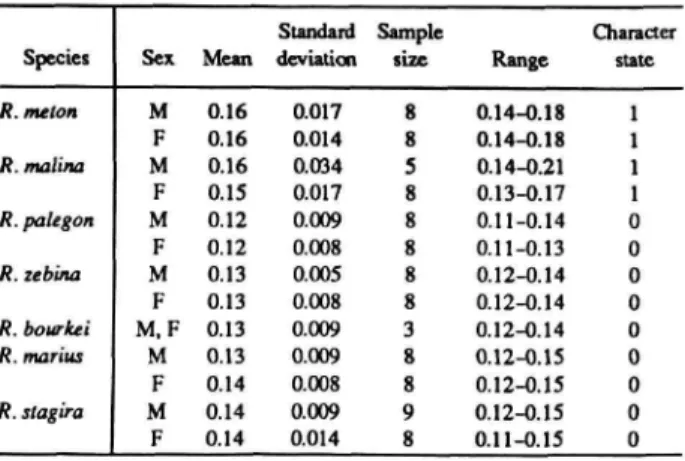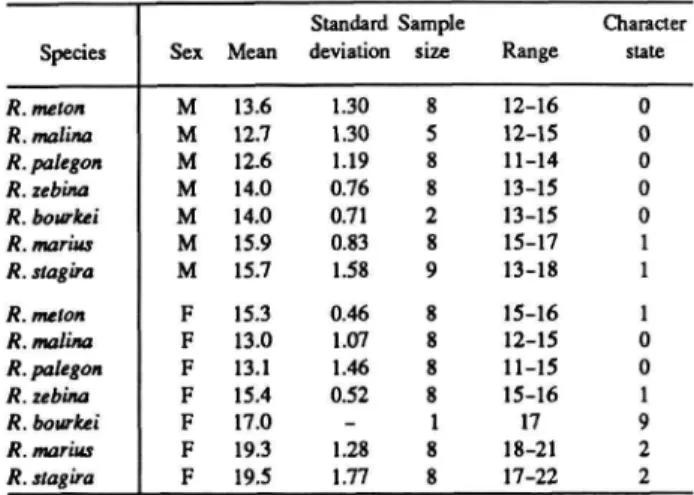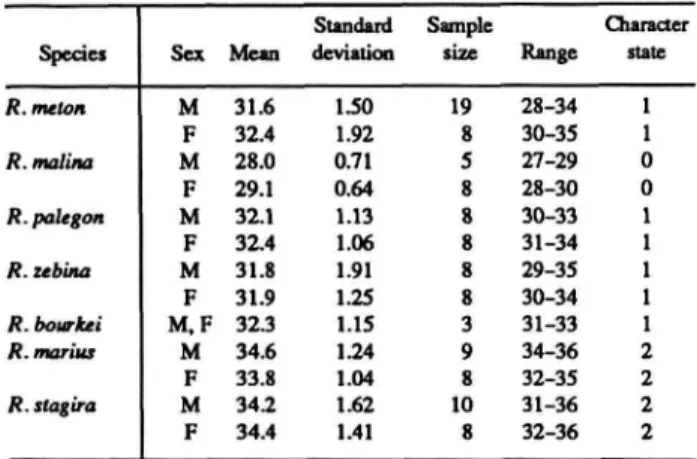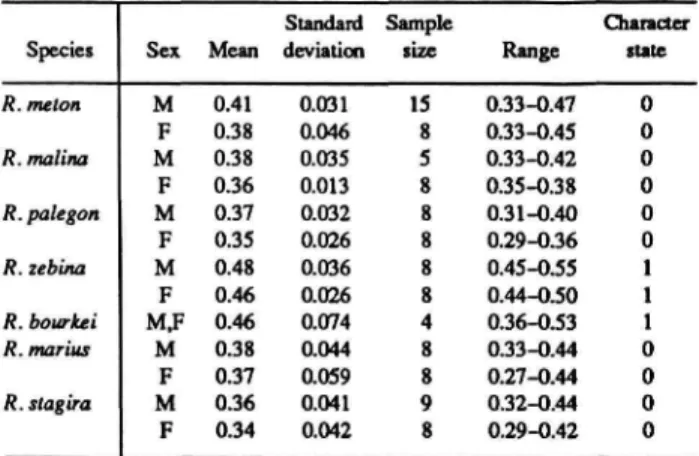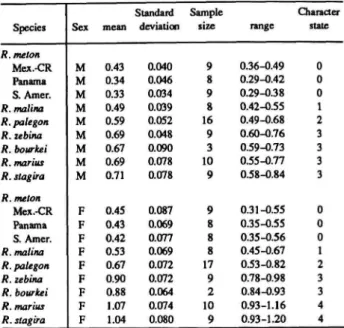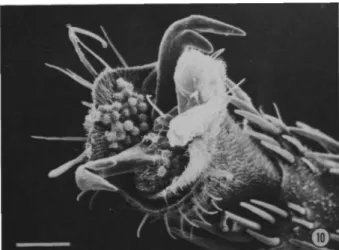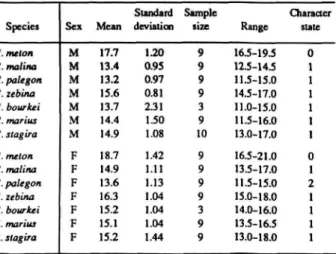About 80% of the species are placed in Thecla Fabricius, a genus that does not belong to the Eumaeini (Eliot, 1973). Furthermore, the groove on the outside of the vinculum becomes the posterior border of the process (Figures 41, 42). When all or none of the character states occur in the outgroup genera, this is also coded 9.

Mean Number of Male Nudum Segments (Table 3): Mean number of segments (0) less than 14.5,
The distributions of these and subsequent characters are summarized in Table 1 for Rekoa species and outgroups Thereus and Arawacus.
Mean Number of Female Nudum Segments (Table 3): Mean number of segments (0) less than 14.5,
Mean Length of Club Segment (Table 4): Mean
Mean Length of Longest Shaft Segment (Table 5): Generally, the longest antennal segment was
This structure occurs in both "higher" and "lower" Lepidoptera (Davis, 1967), including Lycaenidae, and I illustrate a cross-section of the third palpal segment for R. The function and comparative morphology of this structure in the Lycaenidae have not been investigated . described. I have previously reported (Robbins, 1987) on sexual dimorphism in the length of the third segment of the labial palp of Trichonis (Eumaeini), and noted that this dimorphism is widespread in the trunk.
Length of Male Third Palpal Segment (Table 6): Mean length (0) less than 0.46 mm, (1)
Character state 0 occurs in all outgroup species except Thereus gabathana Strand, whose shaft segment length is about 0.43 mm, but only one male and one female have been available for study. I measured the length of this segment in Rekoa using an ocular scale at xlOO and found that it is sexually dimorphic in Rekoa except for/?, meton populations occurring from Mexico to Costa Rica. The distribution of character states is also sexually dimorphic, and I scored third palpal segment length as two characters.
Length of Female Third Palpal Segment (Table 6): Mean length (0) less than 0.49 mm, (1)
The edges of the olfactory hood are accentuated by the extent of the intermembrane pocket. To measure the size of the androconium perfume, I took separate samples from inside and outside the disc cell. Androconia perfume length within discal cell (Table 9): Average length (0) less than 0.14 mm,.
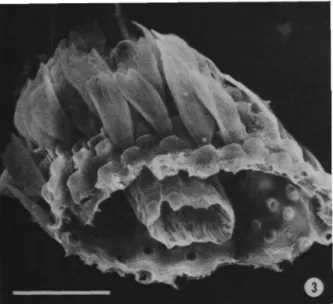
Length of Scent Pad Androconia within Discal Cell Significantly Longer Than Those beyond It (Table
Width of Scent Pad Androconia within the Discal Cell (Table 10): Mean width (0) less than 0.037
Width of Scent Pad Androconia within Discal Cell Significantly Wider Than Those beyond It (Table
Ventral Hindwing Anal Lobe: (0) red and black, (1) a combination of neutral colors, usually tan, gray,
Ventral Hindwing Black Pupiled Red Cubital Spot: (0) present, (1) absent
Ventral Hindwing Submarginal Band: (0) yellow- tan, (1) gray-brown
Brown Ventral Forewing Discal Bar: (0) present, (1) absent
Brown Ventral Hindwing Discal Bar: (0) present, (1) absent
Brown Basal Band across Ventral Hindwing from SC+R1 to Approximately CU2: (0) present, (1)
Ventral Hindwing Postmedian Line below Vein RS: (0) a brown band edged distally with white,
Postmedian Line in Ventral Hindwing Cell SC+R1- RS: (0) a black and white dash co-linear with the
Female Dorsal Ground Color: (0) blue or white, (1) gray-brown, often with a dusting of blue scales
I speculate that the posterior edge of the female seventh abdominal segment fits into the space between the process and the male eighth segment during copulation. The anterior margin of the male eighth tergum projects slightly anteriorly, as it does in many other eumaeine genera, but it is curved, and there is no obvious way to measure it. Another pouch that is more distinct and easier to mark is a heavily sclerotized, semicircular pouch between the female sixth and seventh segments.
Ventral, Sclerotized, Anterior Pointing Internal Pouch between Female Sixth and Seventh Abdomi-
Another variable feature of the Rekoa abdomen is the sclerotized intersegmental sacs on the abdominal venter. A posteriorly directed external sac occurs sporadically between the eumaeine between the second and third segments. I tore the peritoneum laterally and separated the membrane connecting the eighth abdominal segment to the vinculum at its attachment.
After cleaning both the genitalia and the abdominal integument, I usually stained the genitalia with chlorozal black, which stains the membrane, especially the manica (the membrane that attaches the penis to the valves). On some specimens I removed a brush organ (sensu Eliot, 1973) to allow examination of structures supporting the brush organ. Also, much of the membrane that connects the genitals to the abdomen was removed so I could better see the structures.
I did not measure the height and width of either the genital capsule or brush organs because these structures are curved and difficult to measure. Inner penis length (Table 13): I measured this length in lateral view from the anterior end of the penis to the point on the ventral penis where the maniscus attaches. Length of external penis (Table 14): I measured this length in lateral view from the ventral attachment of the meniscus to the ventral posterior tip of the penis.
Dorsal capsule length (Table 15): I measured this distance dorsally from the notch between the labia to the anterior edge of the labia.
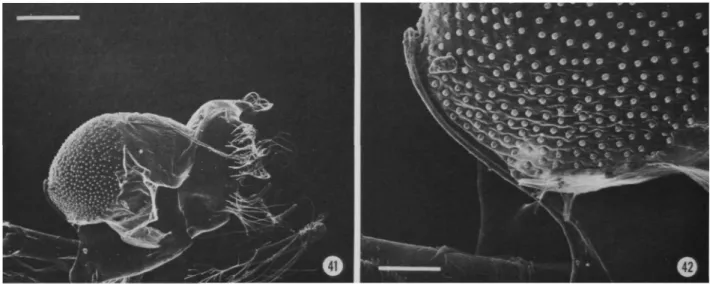
Ventral Process of Tegumen: Many eumaeines have a process that arises from the lateral part of
Valve shape is extremely variable intraspecifically and should be used with great caution as a source of species character states.
Anterior Process of Vinculum: Except for R
Teeth on Ventral Cornutus: The posterior end of the ventral cornutus is expanded and has teeth on
Posterior Tip of the Dorsal Cornutus: (0) posteri- orly twisted to the left with the lateral apices flared
The difference in the shape of this cornutus is one of the best ways to distinguish R. FEMALE GENITALIA (Bursa Copulatrix) - The female genitalia of Rekoa are complex asymmetrical three-dimensional structures with apomorphies that characterize the genus and provide information on its systematic position . I prepared the female genitalia in the same way as the males, but usually left the papillae anals attached to the abdominal cover so that I could better see the lamella postvaginalis.
The genital plates surrounding the posterior end of the ductus bursae vary interspecifically (Figures 56–63), but this variation is not easily used for phylogenetic inference. Like the male genital valves and saccus, they are highly variable intraspecifically, especially the shape of the dorsal genital plates and their spines when present. The posterior segment tapers anteriorly, sometimes with a pointed process on the right ventral surface that extends into the membranous region.
The ductus is strongly dextrally rotated at the membranous area so that the bursa copulatrix is rotated approximately 90 degrees anterior to the membranous area. This extreme asymmetry occurs in all Rekoa species and some Thereus species, but if it evolved independently, as I argued earlier in this article, then it is a derived condition that characterizes Rekoa. The dorsal surface of the anteriorly sclerotized ductus bursae is concave, a widespread, but previously unreported, eumaeine character.
I made three measurements of the ductus bursae, but one of them, which was wide just behind the membranous area, showed no gaps despite interspecific variation.
Length of the Posterior Sclerotized Segment of the Ductus Bursae (Table 16): I measured (at x50)
As with the male genitalia, I have chosen quantitative characters - to reinforce qualitative ones - using the criterion that they can be measured unambiguously. In most species of Rekoa, Thereus, and Arawacus, the left dorsal plate does not extend as far posteriorly as the right. However, the spines in these two species differ greatly in size (Figures 59, 60), and it is not clear that they are homologous.
Length of the Anterior Sclerotized Segment of the Ductus Bursae Measured (at x50) along the Left
FIGURES 51-55.—Structures of female genital organs in Rekoa: 51, anterior end of ductus bursae of /?, palegon showing two internal teeth (scale = 100 \im);. The posterior corpus bursae form a sac, sometimes slightly sclerotized, that is dorsal to the ductus bursae (Figs. 56-63). The ductus seminalis originates from the posterior part of the sac, and sclerotized patches appear laterally at the base of the sac, just above the anterior end of the ductus bursa (Fig. 56).
In Rekoa and some Thereus species, the corpus bursae sac is located on the right side of the butterfly due to the dextral rotation of the female genitalia. They are oval or transversely elongated in the wall of the bursa corpus, unlike the longitudinal elliptical or slit-like structures that usually occur in eumaeines. Further, the anterior half of the signal, both in the corpus wall and in the internal projection (dorsal), is more sclerotized than the posterior half.
The signa have the same heavy anterior sclerotization, and at the wall of the corpus, bursae are almost oval, but are about 1.5 times longer than wide. The inner wall of the corpus bursae is covered with small, anteriorly pointing, sharp teeth (Figure 55). These teeth and the signa can prevent the spermatophore from drifting backwards, where it can easily block the entrance to the ductus seminalis and render the female sterile.
It is not known whether the inner wall of the corpus bursae of other Lepidoptera is also covered with small sharp processes.
Corpus Bursae (Figures 62, 63): (0) without a round area of lightly sclerotized lines surrounding
This female genital structure occurs only in Rekoa, Arawacus, and Thereus, but the sclerotized spots appear to have been lost in R. Although these oval or transverse markings are unique in the Thereus section, the markings of Arawacus tarania and Thereus ortalus are structurally similar to that of Rekoa.
Shape of Signa at the Wall of the Corpus Bursae (Figures 56-63): (0) oval or nearly so, (1) trans-
Third, specimens from the Amazon basin have a pale yellow spot in the center of the ventral hindwing that contrasts with the rest of the wing. Although the ventral wing pattern of specimens in the southern part of the range could be confused with that of R. There is a specimen in the BMNH that fits the original description, and I designate it the lectotype.
There is a specimen in the BMNH that fits this description, and I designate it as the lectotype. There is a male of this species from Mexico in the BMNH, which I designate lectotype. There is a male in the BMNH that fits the original description; I designate it the lectotype.
The type of Thecla madie is in the MCZ, fits the original description and is unrelated to Rekoa. Thecla timaea Hewitson, 1869: Hewitson described and illustrated Thecla timaea from a female in the collection of H.W. There is a Nicaraguan female in the BMNH that fits the original figure, and I designate it the lectotype of T .
The lack of pale blue scales in the ventral hindwing submarginal spot, as indicated in the Key, distinguishes R.
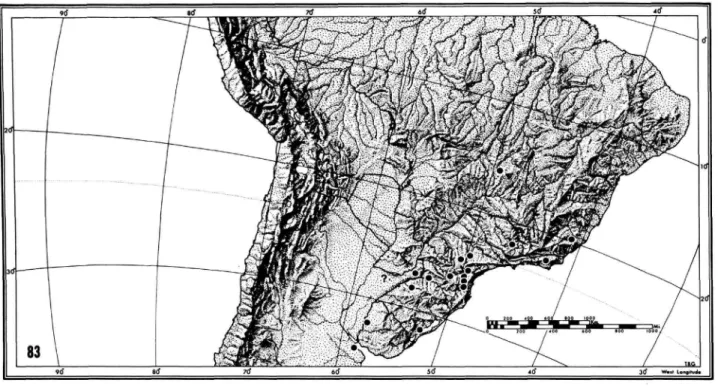
Literature Cited
A new family of monotrisian midges from Australasian South America (Lepidoptera: Palaephatidae), with a phylogenetic review of monoirisia. On the frequency of butterflies in eastern Brazil with a list of the butterfly fauna of the Pocos de Caldas, Minas Gerais. A revisional study of the Neotropical butterfly genus Noreena and its new sister genus Contrafacia (Lepidoptera: . Lycaenidae).
Ti baro a henero dagiti kulibangbang ti Hairstreak Orcya, ti rebision ti Neotropiko a grupo ti Orcynia "Thecla" (Lepidoptera: Lycaenidae). Dagiti Panagadal iti Henera dagiti Amerikano a Hairstreaks, 5: Panagrepaso ti henero ni Hubner a Parrhasius ken panangiladawan ti baro a henero ti Michaelus (Lycaenidae: Eumaeini). Dagiti panagadal kadagiti henero dagiti Amerikano nga ipus ti buok, 6: Ti panagrepaso ti henero ni Hubner nga Olynlhus (Lycaenidae: Eumaeini).
Evolution and identification of the New World Hairstreak butterflies (Lycaenidae: Eumaeini): Eliot's Trichonis section and Trichonis Hewitson. Synonymy in zoology must use the short form (taxon, author, year: page), with full citation at the end of the article below. Extensive notes should be collected and placed in a notes section at the end of the text.
For titles of books and articles, use capital letters in sentence form, according to the rules of the language used (exception: capitalize all important words in English).

